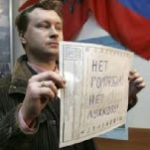It’s easy to visit pretty Copenhagen and appreciate its culture, architecture and social scene but the city works because of the workers, many of whom rise before dawn to drive buses, bake pastries and dig holes for underground pipes. Here is a photo essay about the varied and valued ‘Workers of Copenhagen’.
See other stories and photos of Copenhagen
Also see Denmark Information
By Richard Ammon
GlobalGayz.com
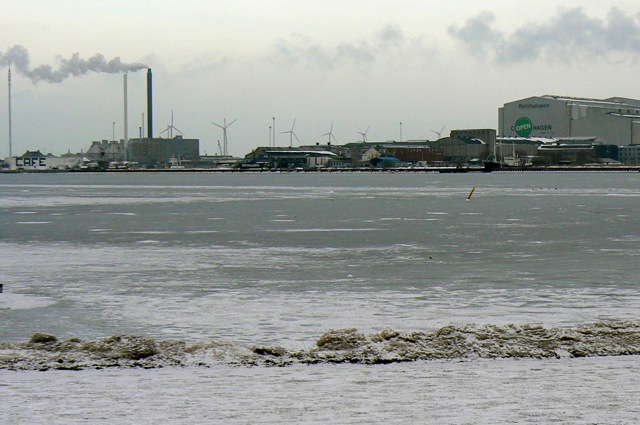
Across the harbor from the city center, one of the most important jobs is keeping the central heating system up and running. Copenhagen has an ingenious method of heating virtually all buildings in the city from steam plants like this (photo left) to heat the radiators in homes and offices.
The Metropolitan Copenhagen Heating Transmission Company, CTR for short, is a partnership formed in 1984 by the municipalities of Frederiksberg, Gentofte, Gladsaxe, Copenhagen and Tarnby. CTR has the objective of supplying the individual municipalities with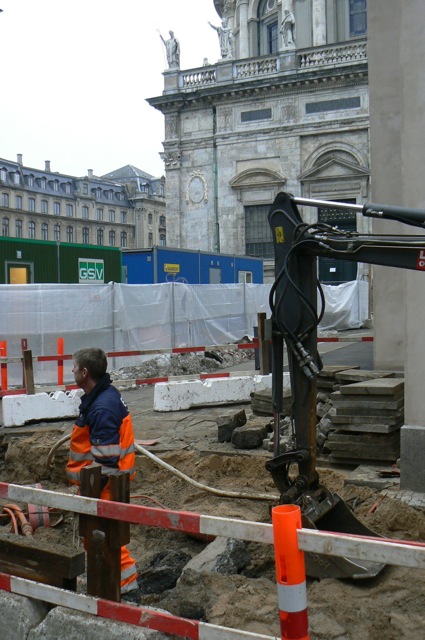 The transmission system consists of 54 km of double piping, 26 heat-exchanger stations, 3 pumping stations, 12 peak-load and back-up units, as well as a computer-based control, regulation and monitoring system. district heating, primarily based on surplus heat from waste incineration plants and combined heat and power generation plants (CHP plants). Oil-fired heating plants are only used in peak-load and/or back-up situations.
The transmission system consists of 54 km of double piping, 26 heat-exchanger stations, 3 pumping stations, 12 peak-load and back-up units, as well as a computer-based control, regulation and monitoring system. district heating, primarily based on surplus heat from waste incineration plants and combined heat and power generation plants (CHP plants). Oil-fired heating plants are only used in peak-load and/or back-up situations.
With such an enormous subterranean heat pipe system, maintenance is a constant and underappreciated job to replace old conduits and install new ones. Photo right shows city workers digging holes to access the pipes, a job that continues year round through rain and snow. Care is taken not to disturb historic buildings such as Frederick’s church seen in the background here.
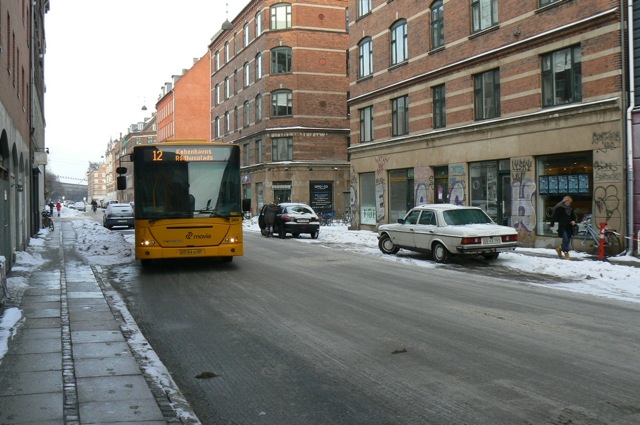 The next important job is getting the enormous bus system going that transports thousands of people to their work in offices, shops, schools, transport and cultural venues. Buses run on precise schedules that are posted neatly on signposts at each stop.
The next important job is getting the enormous bus system going that transports thousands of people to their work in offices, shops, schools, transport and cultural venues. Buses run on precise schedules that are posted neatly on signposts at each stop.
Many of these posts have digital displays that tell what bus is coming next and in how many minutes. The longest wait is no more than twelve minutes in the day time and twenty at night.
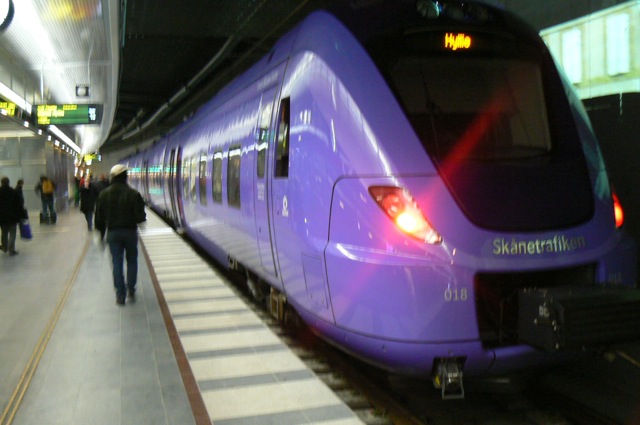 The train system (DSB) and Metro subways are remarkable for their efficiency, quality, frequency and on-time schedules. All rail cars are new or near-new and have routes to all parts of the country. There is also frequent service to the Swedish coastal cities of Malmo (photo right) and Gothenborg.
The train system (DSB) and Metro subways are remarkable for their efficiency, quality, frequency and on-time schedules. All rail cars are new or near-new and have routes to all parts of the country. There is also frequent service to the Swedish coastal cities of Malmo (photo right) and Gothenborg.
DSB employs a staff of approximately 9,300 workers and carries more than 195 million passengers every year with precision and reliability. Maintenance work on most Danish railway lines is done by Banedanmark, a state-owned company that also allocates tracks for train operators.
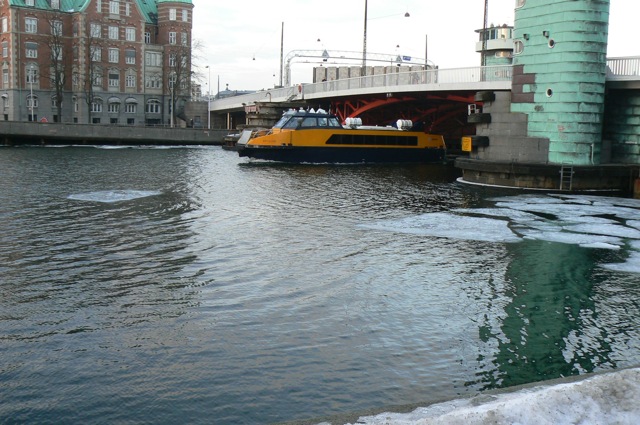 In addition to trains, subways, buses, bicycles there are boat taxis, or water buses, that connect more than thirty places of current and historic places such as the opera house and the national library.
In addition to trains, subways, buses, bicycles there are boat taxis, or water buses, that connect more than thirty places of current and historic places such as the opera house and the national library.
The water buses sail in the canals of Copenhagen and through the harbor area. There are no guides on board and are meant as a ‘hop on hop off’ sightseeing. They sail between the Little Mermaid in the north via Gammel Strand, The Black Diamond library in central to Fisketorvet shopping center in the southern part of the city. Behind this service are dedicated staff who offer courteous and knowledgable service all year long.
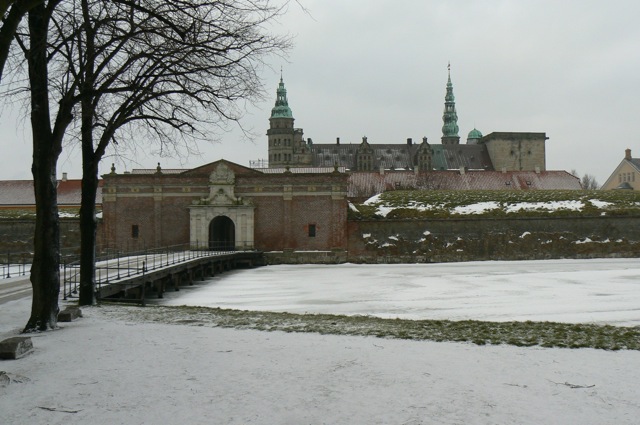
The rail sytem connects workers and tourists to famous heritage sites such as ‘Hamlet’s Castle’ in Helsingor, aka Elsinore (photo right). Started in the 15th century it became the most glorious and wealthy castle home to the Danish kings who collected taxes on every cargo ship that passed by on the Oresund Sound, one of the main shipping routes to mainland Europe.
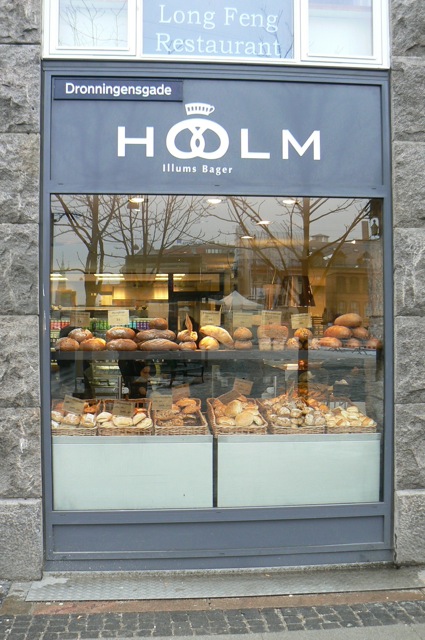 To get the workers to work requires good food in the form of Danish pastries, called Danish! Made fresh daily and sold in countless bakeries across the country. It’s hard to resist these tasty sweets that range from cheese to meat, from fruit to chocolate.
To get the workers to work requires good food in the form of Danish pastries, called Danish! Made fresh daily and sold in countless bakeries across the country. It’s hard to resist these tasty sweets that range from cheese to meat, from fruit to chocolate.
The baking industry in Denmark is huge. In order to provide these mouth-watering treats early each day involves an extensive procurement 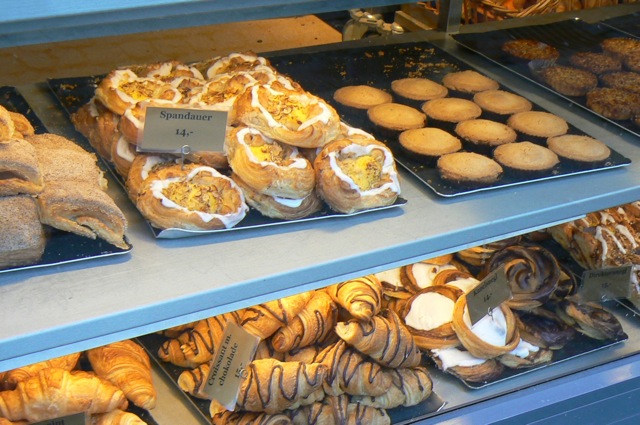 system for flour, sugar, salt, jellies, chocolate, cheese, meats, wrapping paper and more–all trucked in by drivers and deliverymen on scheduled times and accounted for by office workers who keep track of financial, mechanical and food supply matters.
system for flour, sugar, salt, jellies, chocolate, cheese, meats, wrapping paper and more–all trucked in by drivers and deliverymen on scheduled times and accounted for by office workers who keep track of financial, mechanical and food supply matters.
One of Copenhagen’s most outstanding classical-cum-modern architectural attractions is the Royal Library. It contains numerous historical treasures; all works that have been printed 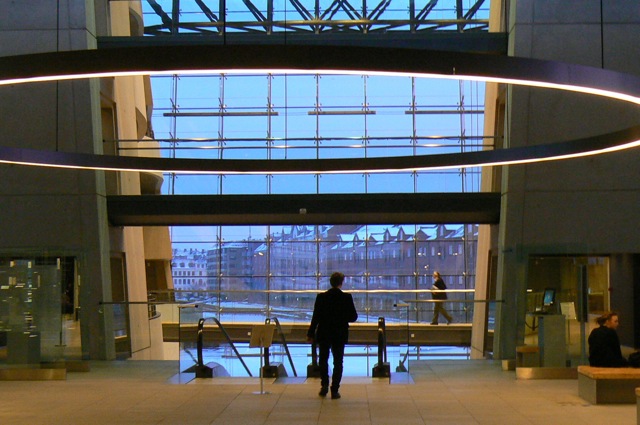 in Denmark since the 17th century are deposited there. Thanks to extensive donations in the past the library holds nearly all known Danish printed works back to the first Danish book, printed in 1482.
in Denmark since the 17th century are deposited there. Thanks to extensive donations in the past the library holds nearly all known Danish printed works back to the first Danish book, printed in 1482.
The extensive library employs over a hundred workers, from administrative officers to research specialists to cafe servers, book sellers and of course the night cleaning crew.
The library actually has four sites. In 1999, a new building adjacent to the old one was opened at Slotsholmen, known as the Black Diamond. Named for its outside cover of black marble and glass, it houses a concert hall in addition to the library. Photo above is of the new main lobby.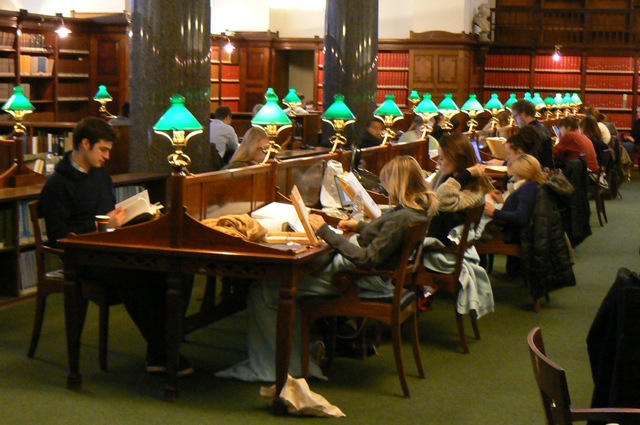
The next photo may not look like people hard at work but these students are the future of Denmark’s continued prosperity and expertise in science, arts, politics, medicine, construction, technology, engineering and the creative artists who will advance the famous Dansk lifestyle.
In 1989 the state library was merged with the prestigious University Library (founded 1482) and in 2005 it was merged with the Danish National Library for Science and Medicine, now the Faculty Library of Natural and Health Sciences).
Prior to universtiy studies are many years of learning in primary and middle schools. Not all teaching is done in classrooms, however. In the nearby city of Roskilde there are two major historical learning sites: the Royal Cathedral where centuries of Danish royalty are enshrined in 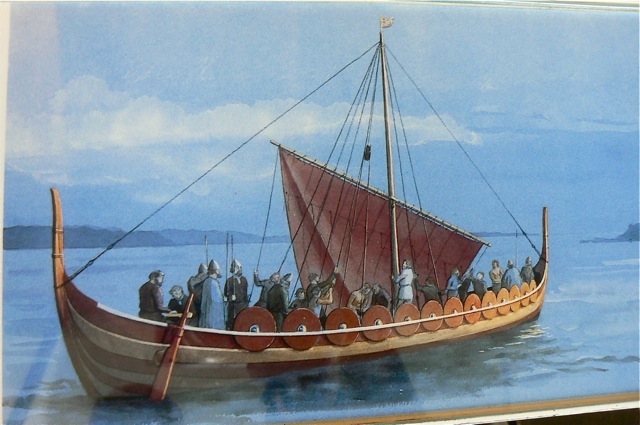 marble sarcophagi; and the more modern Viking Ship Museum (for ships, seafaring and boatbuilding) that displays 5 actual ancient viking ships (found underwater buried in mud since the 11th century).
marble sarcophagi; and the more modern Viking Ship Museum (for ships, seafaring and boatbuilding) that displays 5 actual ancient viking ships (found underwater buried in mud since the 11th century).
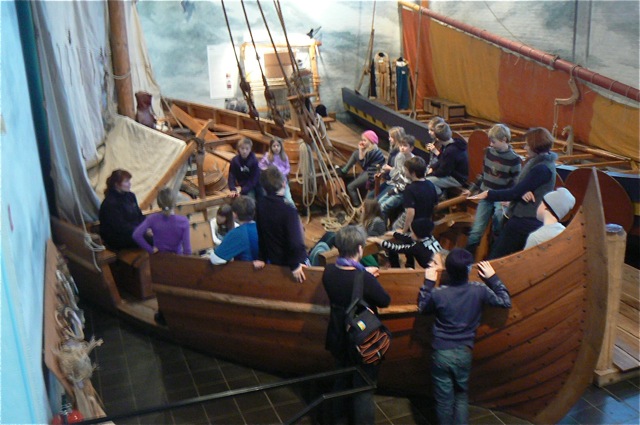 Here countless school children come each day (photo right) to listen to the museum staff workers, teachers and guides who describe the life and times of the viking era that peaked in the middle ages.
Here countless school children come each day (photo right) to listen to the museum staff workers, teachers and guides who describe the life and times of the viking era that peaked in the middle ages.
The term Viking is customarily used to refer to the Scandinavian explorers, merchants and pirates who raided, traded, explored and settled in wide areas of Europe and the North Atlantic islands from the late 8th to the mid-11th century.
Speaking of royalty, the present monarch is Queen Margrethe II, born in 1940. Her father King Frederik IX died in 1972. On the occasion of her accession to the throne on 14 January 1972, Queen Margrethe II became the first female Danish sovereign under the new Act of Succession of 1953. She previously had married French diplomat Count Henri Laborde de Monpezat who received the title of ‘His Royal Highness Prince Henrik of Denmark’.

Despite being royal, they are also workers for the state as goodwill ambassadors, charity sponsors and officiating at political and diplomatic events. They also have a family of two sons and some grandchildren. The queen is well educated with interests in archeology, history, economics and the arts.
One night she attended, as I did, a modern dance performance at the grand and ornate Theatre Royal given by the Bill T Jones/Arnie Zane dance company of New York. 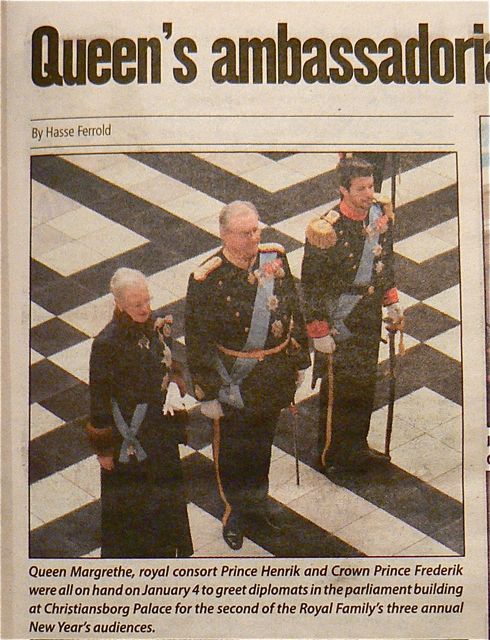 At seventy she is broad minded and appeared attentive to the unorthodox experimental dance show on stage. As a result she is well liked in the country. The photo (left) of the queen was taken by me at the Royal Theatre before the Jones performance.
At seventy she is broad minded and appeared attentive to the unorthodox experimental dance show on stage. As a result she is well liked in the country. The photo (left) of the queen was taken by me at the Royal Theatre before the Jones performance.
One of her many obligations happens each January when she receives the ambassadors of foreign governments at the Parliament building at Christiansborg Palace (newspaper photo and partial headline, right) to approve their official presence in Denmark.
It’s a grand formal ceremony with speeches and good manners. Included in the formalities is the Queen’s husband ‘royal consort’ Prince Henrik as well as the heir to the throne Crown Prince Frederik, all three pictured right. There are three such annual audiences held in order to 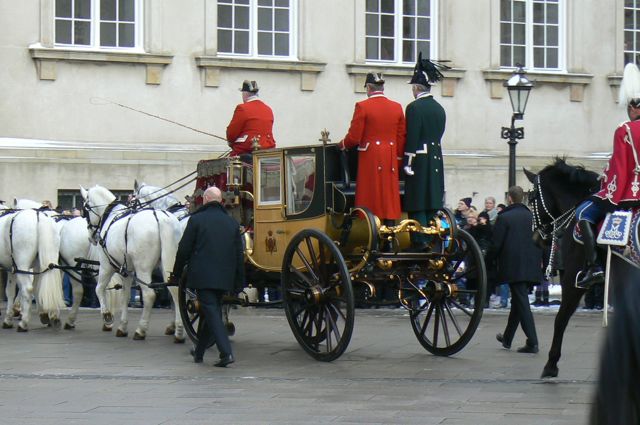 accommodate the many ambassadors who are appointed to Denmark.
accommodate the many ambassadors who are appointed to Denmark.
As befits a monarch, she is afterwards escorted from the parliamentary palace to her own private palace half a mile away in a golden horse-drawn carriage surrounded by horseguards in colorful uniforms. It’s all quite impressive as the guards line up their horses on both sides of the coach in traditional military style to display loyalty and strength.
The other major performance venue (actually one of several) is the ultra modern national opera house (in Danish usually called Operaen). It’s among the most modern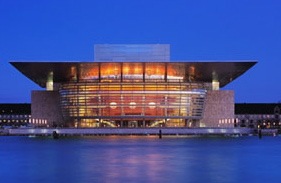 opera houses in the world. It is also one of the most expensive opera houses ever built with construction costs well over 500 million U.S. dollars (paid for by A.P. Møller, co-founder of the shipping company now known as Mærsk)).
opera houses in the world. It is also one of the most expensive opera houses ever built with construction costs well over 500 million U.S. dollars (paid for by A.P. Møller, co-founder of the shipping company now known as Mærsk)).
Inside, before each performance, the restaurant workers scurry about to serve dinner and drinks to many audience members. Waiters in this venue work under tight constraints to get everyone served before curtain time. It takes concentration and coordination to balance all the demands of patrons in such an upscale place. It all works smoothly as a result of polished routines; the on-stage drama is not the only action that takes rehearsal time and talent.
Needless the say, the opera singers display their weeks, months and years of training work after the curtain rises. On this particular night Puccini’s La Boheme was mounted to the satisfaction of the full house–despite the snowstorm that blew into Copenhagen during the performance.
On the opposite side of town is the alternative (hippie) village called Christiana, a world 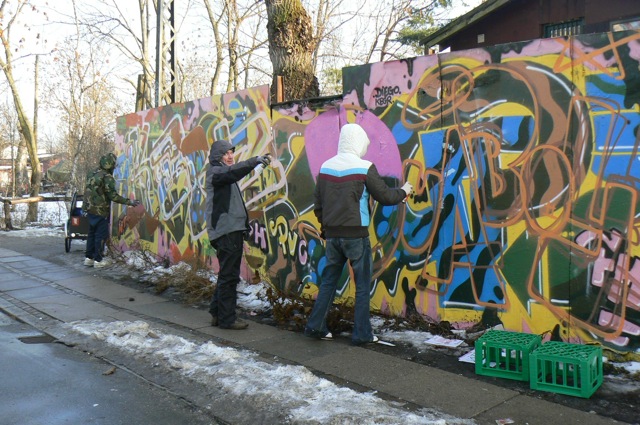 famous ‘experiment’ (started in 1971) in communal living that has succeeded, essentially, by dedicated workers commited to equality, ecology, non-violence and freedom from government intervention (well, almost). The work there takes many forms from bakers to carpenters to shop keepers to bicycle-makers to postmaster to graffiti artists and negotiators with the government.
famous ‘experiment’ (started in 1971) in communal living that has succeeded, essentially, by dedicated workers commited to equality, ecology, non-violence and freedom from government intervention (well, almost). The work there takes many forms from bakers to carpenters to shop keepers to bicycle-makers to postmaster to graffiti artists and negotiators with the government.
The photo left shows a small portion of the long wall surrounding Christiana that is constantly under artistic renovation by residents of the village. Meditation and yoga have always been popular among the Christianites.
More manual and more productive work is done by the owners of the Optimisten joinery shop who make furniture, cabinets and other wood products.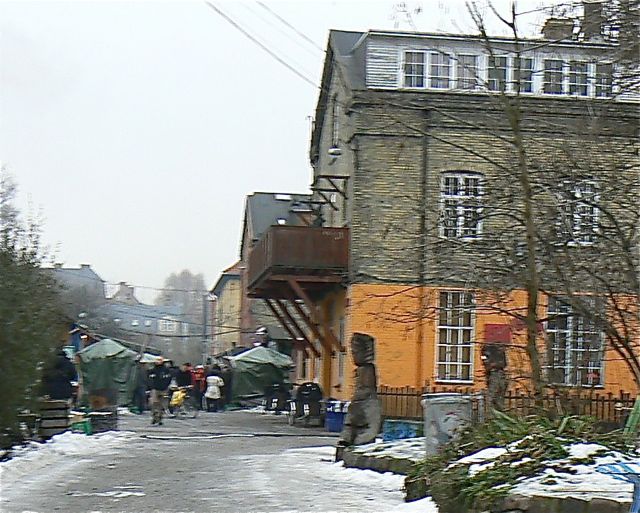 The place is a for-profit business that pays a portion of the common charges to sustain the village (property taxes, water, heat) shared among hundreds of other professional workers who reside here. About 1000 people live permanently in Christiana, which is self-governed up to a point.
The place is a for-profit business that pays a portion of the common charges to sustain the village (property taxes, water, heat) shared among hundreds of other professional workers who reside here. About 1000 people live permanently in Christiana, which is self-governed up to a point.
I’m not sure if the same holds for the controversial hash sellers who operate informal (and quickly removable) kiosks selling hash from a dozen countries along Pusher Street–the actual name of the main street in Christiana. Prices range from US$15 to $25 a gram.
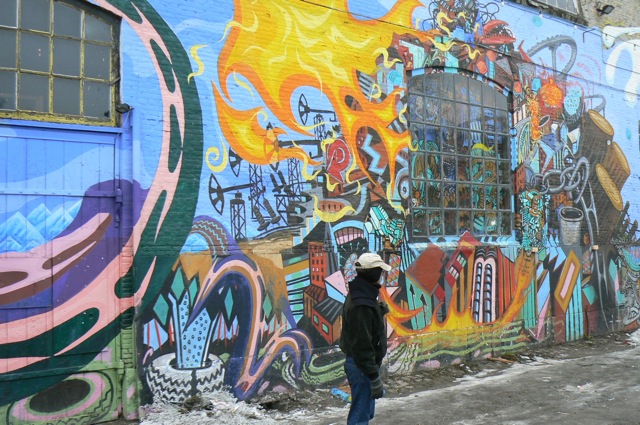 No close-up photos were allowed of these ‘professionals’ who keep their wares half hidden under camouflage canvas covers because of the ever-present risk of a police ‘visit’. The sale of hard drugs (heroin, cocaine) is strictly forbidden in the village but the sale of hash somehow is minimally tolerated here. (Photo above right shows, at a distance, a couple of covered kiosks in the center background along Pusher Street.) Most residents do not approve of the pushers, preferring ‘real work’ instead.
No close-up photos were allowed of these ‘professionals’ who keep their wares half hidden under camouflage canvas covers because of the ever-present risk of a police ‘visit’. The sale of hard drugs (heroin, cocaine) is strictly forbidden in the village but the sale of hash somehow is minimally tolerated here. (Photo above right shows, at a distance, a couple of covered kiosks in the center background along Pusher Street.) Most residents do not approve of the pushers, preferring ‘real work’ instead.
Whatever controversy may swirl around Christiana’s existence, it is a noticably colorful alternative village (photo left) whose residents spend much of their time as productive workers inside and outside the graffiti walls.
As a swimmer, two of my favorite places during this visit were the swimming pools in the city. I appreciate the workers at these indoor wet venues whose daily jobs are important to the sporting health of Copenhagen water-lovers. Their jobs are not particularly exciting but they are there every day, on time and always cordial. There are several pools in the metropolitan area but the two I know are the DGI-byen sports complex and the Bellahoj Aquatic Center.
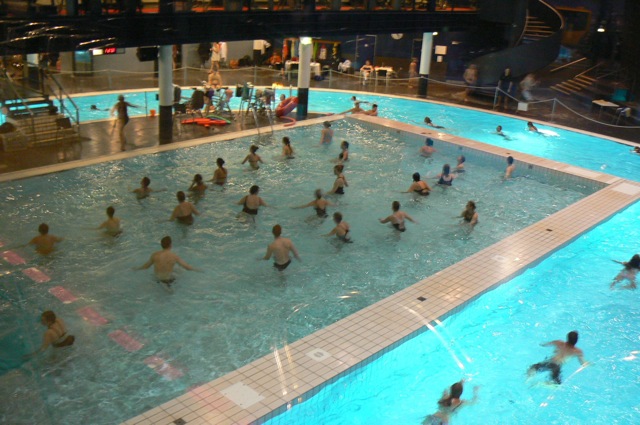
DGI-byen complex (photo left) is a popular venue for cultural, corporate and sports events. With 22,000 square metres of area, DGI-byen offers a range of conference facilities, a café, restaurant, party and banquet rooms and three hotels. In addition there is the Swim Center, The Spa, The Bowling Alley and Fitness Gym. The result is a dynamic, flexible multi-centre, availed of daily by schools, sports clubs, companies, foreign tourists and local visitors.
The unique feature of the indoor swimming pool here is its circular shape; one lap around the pool is about 100 meters. There’s an exercise pool is in the middle island of the circle; off to the side are large shallow pools where parents can play with their children.
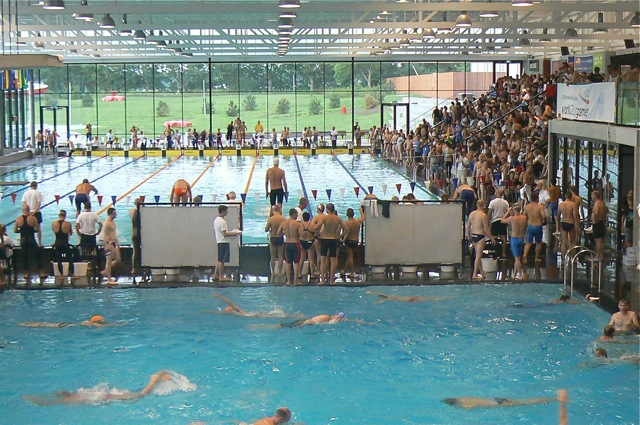
The huge glass-walled Bellahoj swimming stadium (photo right) is made up of a diving pool, a training pool plus the first regulation size 50-meter pool in Copenhagen, complete with changing rooms, café and bleechers that seat 1200 spectators. This was the swimming venue for the 2009 gay ‘olympics’ known as the OutGames, held every four years. (photo right was taken at the OutGames)
Workers at these venues are kept busy with the hundreds of people who come every day, many with kids. It takes constant vigilance and knowledge of life-saving skills by the lifeguards to keep things safe and orderly.
Copenhagen is also well known for its tolerant attitude toward gay and lesbian citizens (LGBTs). There are perhaps as many as 50,000 LGBT people who live and work in and around the city 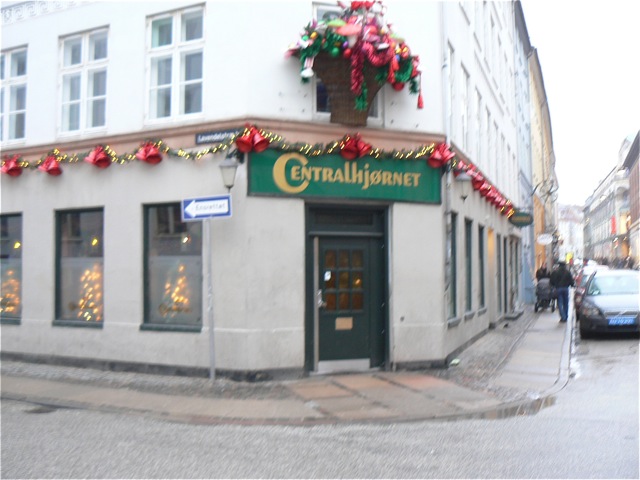 in every possible profession, including city and state government officials. Some are ‘out’ some are not. There are about 25 LGBT businesses and orgnizations that range from health agencies (StopAIDS) and advocacy organizations (LBL) to saunas
in every possible profession, including city and state government officials. Some are ‘out’ some are not. There are about 25 LGBT businesses and orgnizations that range from health agencies (StopAIDS) and advocacy organizations (LBL) to saunas 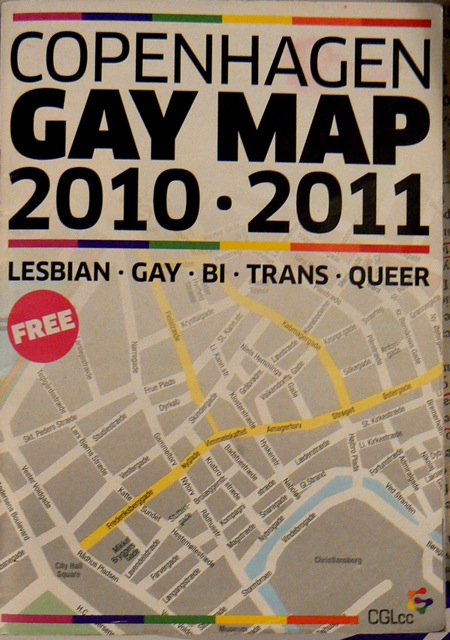 and bars. (photo left, Copenhagen’s oldest gay bar, Centralhjornet)
and bars. (photo left, Copenhagen’s oldest gay bar, Centralhjornet)
An annual Gay Map is printed each year for foreign visitors in the form of a 32-page booklet that lists every LGBT gay-owned and gay-friendly venue in the city. It’s produced by the Copenhagen Gay and Lesbian Chamber of Commerce in cooperation with Out & About, the monthy Danish LGBT magazine.
Of course each of these business places require a lot of time and work, like any other 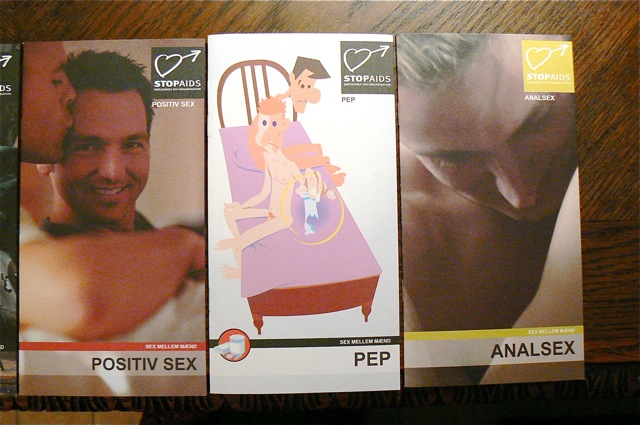 commercial effort. LGBT workers provide a valuble service to the gay community, both local and foreign, especially in the warm season when thousands of LGBT tourists come to Copenhagen. (photo right, StopAIDS HIV-prevention brochures)
commercial effort. LGBT workers provide a valuble service to the gay community, both local and foreign, especially in the warm season when thousands of LGBT tourists come to Copenhagen. (photo right, StopAIDS HIV-prevention brochures)
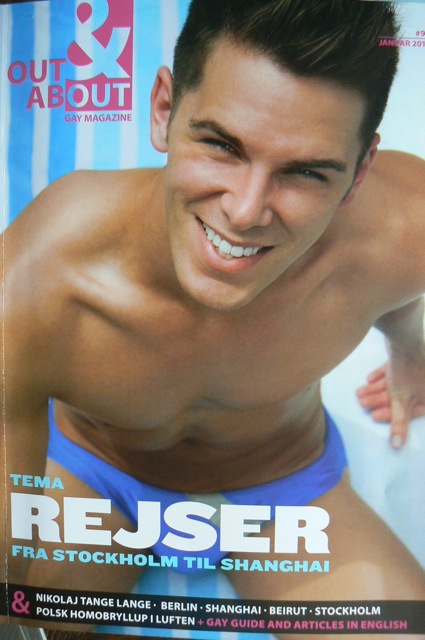 In summer 2009 the city hosted the OutGames sports extravaganza and Human Rights conference that brought about 35,000 LGBT participants and spectators to Denmark.
In summer 2009 the city hosted the OutGames sports extravaganza and Human Rights conference that brought about 35,000 LGBT participants and spectators to Denmark.
A great deal of work was involved in that huge effort, much of it volunteered, much of it professionally and commercially provided by a small army of constructors, electricians, plumbers, drivers, sales staff, painters, food prep workers, to name a few. (photo left, Denmark’s LGBT magazine ‘Out & About’)
The workers of Copenhagen are very diverse, skilled, professional and friendly and make the city one of the safest and most efficient of any major city–for all citizens.


